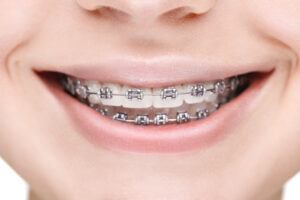
Understanding Metal Braces: Pros, Cons, and Considerations
When you need to straighten your teeth, you have several treatment options. You may have heard a lot about Invisalign lately, but is it right for you or your child? Both metal braces and Invisalign are effective methods to address alignment concerns. Each orthodontic approach has its pros and cons. Choosing the best option depends on your unique correction needs and lifestyle.
Traditional Braces
The process and technology of this type of braces can treat almost any orthodontic case. With this versatile teeth-straightening system, we adhere metal brackets to the enamel of each tooth with dental glue, then add wires to them with small rubber bands, called ligatures. These archwires help realign the teeth by applying gentle pressure.
Patients undergoing this type of treatment have regular appointments in our office for adjustments. Adjustments refer to the process of tightening braces after the teeth move. The highly skilled staff at Boley Braces checks the wires and brackets and makes adjustments regularly. This process typically occurs every four to six weeks to ensure continual progress toward straight teeth!
During these appointments, we also replace the elastic bands. The rubber bands come in many colors, allowing the patient to choose the tones they prefer when they come in for an adjustment. Patients often enjoy choosing new colors according to their moods, outfits, the seasons, sports teams, and more.
Metal braces are the standard type of orthodontic treatment. You may think of them as bulky and painful, but they are smaller and more comfortable than ever before with today's technology. The proven effectiveness of conventional braces makes them an excellent option for anyone with complicated orthodontic issues.
Invisalign
Invisalign is a brand of teeth aligners made of flexible, transparent, BPA-free plastic. These custom-made aligners fit over the teeth to help guide them into the desired position. Wearers remove the trays to eat, drink, and brush their teeth. As the teeth move, new aligners replace old ones to keep the teeth gradually progressing toward the goal.
People using this treatment option must wear the Invisalign trays 22 hours a day. This method is not ideal for those who may not wear them for the recommended amount of time. Patients must soak and clean aligners once per day to avoid discoloration and bacteria growth. Proper care is essential to prevent damage to the trays.
Pros and Cons of Traditional Metal Braces
There are many advantages to both Invisalign and traditional braces. The most suitable option for your treatment at Boley Braces depends on various factors, including the issues we must address.
Pros
Here are some ways that conventional orthodontic treatment provides benefits:
- Braces can address almost any orthodontic problem, including conditions that Invisalign can not correct. Some situations that may require metal braces include:
- Severe overbite
- Large tooth gaps
- Extreme overcrowding
- Rotated teeth
- Short teeth
- Existing bridgework
- Braces are highly durable. The surgical grade stainless steel used to make these braces can withstand the daily activity of your teeth with some restrictions.
- Braces stay in place. We cement brackets to the teeth, making this option suitable for teens or tweens who may lose or break clear aligners. Since Invisalign is removable, patients may not always comply with the suggested daily use of the trays.
- Metal braces may reduce the total treatment time. Because they are not removable, traditional braces work to consistently move the teeth 24 hours a day, every day. Depending on the correction needs, patients may require less time overall to achieve the desired results.
- Conventional braces are typically a more affordable choice. However, the price of treatment varies based on needs. Dental insurance may cover the total amount or a portion of the costs.
Cons
Some disadvantages to this kind of braces include:
- This approach requires patients to avoid hard or sticky foods. These kinds of foods can get stuck under the wires or damage components of the braces.
- This treatment method requires diligent oral hygiene. Due to the permanent brackets on the teeth, braces can cause plaque build-up, tooth decay, or gum disease if patients do not brush and floss as recommended.
- This option may cause discomfort. Depending on circumstances, metal wires and brackets may irritate or poke the inside of your mouth.
- This method is more visible than Invisalign. Technological advances allow for smaller, less conspicuous brackets, but they are still more noticeable than clear aligner trays.
Comprehensive Orthodontic Treatment
At Boley Braces in Harrison and Cincinnati, OH, we provide many treatment options. Our skilled, knowledgeable staff can help determine the best course of treatment for your unique needs. Dr. Boley knows the ideal methods to use for each orthodontic issue to get the best results.
Metal braces may be suitable for patients who are not disciplined or have complex orthodontic problems to correct. Invisalign is a practical option for those who want to have something less noticeable and will take the time to care for the aligners properly.
When you trust us with your braces needs, you get straight teeth, a healthier mouth, and more reasons to smile! Contact us at our Muddy Creek office or our Harrison office today to schedule a free consultation. Dr. Boley uses many types of braces to ensure patients get the results they want.
Featured Image: nizas/Shutterstock
